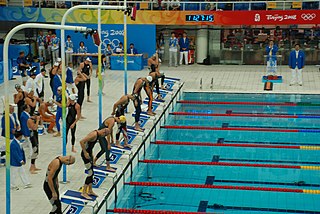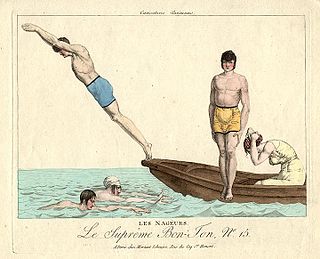
A skin-tight garment is a garment that is held to the skin usually by elastic tension using some type of stretch fabric. Commercial stretch fabrics ('elastomerics') such as spandex or elastane came onto the market in 1962, and revolutionized many areas of the clothing industry. A wide variety of clothing may be made to be skin-tight, and it is common for clothing to be skin-tight for some uses, such as in stockings, bodystockings, swimsuits and women's bras.

A swimsuit is an item of clothing designed to be worn by people engaging in a water-based activity or water sports, such as swimming, diving and surfing, or sun-orientated activities, such as sun bathing. Different types may be worn by men, women, and children. A swimsuit can be described by various names, some of which are used only in particular locations or for particular types of suit, including swimwear, bathing suit, bathing attire, swimming costume, bathing costume, swimming suit, swimmers, swimming togs, bathers, cossie, or swimming trunks, besides others.
Speedo International Limited is an Australian-British distributor of swimwear and swim-related accessories based in Nottingham, England.

A one-piece swimsuit most commonly refers to swimwear worn primarily by women and girls when swimming in the sea or in a swimming pool, playing water polo, or for any activity in the sun, such as sun bathing. Today, the one-piece swimsuit is usually a skin-tight garment that covers the torso, although some designs expose the back or upper chest.

Competitive swimwear refers to the swimsuit, clothing, equipment, and accessories used in the aquatic sports of swimming, diving, artistic swimming, triathlon, and water polo.

A swimming cap, swim cap or bathing cap, is a tightly fitted, skin-tight garment, commonly made from silicone, latex or lycra, worn on the head by recreational and competitive swimmers.

TYR Sport, Inc. is an American designer, developer and manufacturer of competitive swim and triathlon apparel and related specialized athletics gear. It shares ownership with Swimwear Anywhere.
High-technology swimwear, or tech suits, are scientifically advanced materials used for swimwear in competitive water sports such as swimming and triathlon. Materials of this type are normally spandex and nylon composite fabrics with features to reduce drag against the water. The fabrics include features that increase the swimmer's glide through water and reduce the absorption of water by the suit as opposed to regular swimsuits. Additionally, the suits are extremely tight, which make the swimmers body more streamlined and help reduce the buildup of lactic acid in the body. Since 2010, high-tech swimsuits, specifically those offering significant performance-enhancing features and made from non-textile materials, have been banned in professional competitive swimming. This decision was made by FINA after the 2008 and 2009 swimming seasons, during which many world records were broken by swimmers wearing high-tech swimsuits, raising concerns about the impact of technology on the sport.

Open water swimming is a swimming discipline which takes place in outdoor bodies of water such as open oceans, lakes, and rivers. Competitive open water swimming is governed by the International Swimming Federation, World Aquatics, except when it is part of multi-sport events, which are governed by the World Triathlon.
Aquashift is a high-end technical swimsuit made by American swimwear company TYR which was released in early 2004. It incorporates years of research that TYR performed with the Center for Research and Education in Special Environments (CRESE), at the University at Buffalo. The suit sports the "Tripwire", a feature unique to TYR and the Aquashift suit, that reportedly reduces drag by a very large percentage. The suits are made of a blend of 74% polyester and 26% Lycra. The line of suits offers a bodyskin for both men and women, a kneeskin for men and women, and a regular women's suit. The price range for these suits is roughly $120 for a pair of jammers to about $380 for a bodyskin.
The swimming competitions at the 2008 Summer Olympics took place from 9 to 17 August 2008 at the Beijing National Aquatics Centre. The newly introduced open water marathon events (10 km) were held on 20 and 21 August 2008 at Shunyi Olympic Rowing-Canoeing Park.

The LZR Racer is a line of competition swimsuits manufactured by Speedo using a high-technology swimwear fabric composed of woven elastane-nylon and polyurethane. The swimsuits are available in a full-body length; they compress the body and trap air for buoyancy. The LZR Pro and LZR Elite were launched on 13 February 2008; the higher-priced LZR Elite was replaced by the LZR Elite 2 in early 2014. The LZR X was launched in early 2015. The technology is patented in Italy, and protected worldwide.

A swim brief or racing brief is any briefs-style male swimsuit such as those worn in competitive swimming, diving and water polo. The popularity of the Australian Speedo brand racing brief has led to the use of its name in many countries around the world to refer to any racing brief, regardless of the maker. Occasionally, the speedo genericized trademark is applied to square cut swimsuits, but in general the generic term is used in reference to swimming briefs. Swim briefs are also referred to as competition briefs, swimming trunks, bathers, togs, racer bathers, posing briefs, racing briefs, and colloquially in Australia, New Zealand, and the United Kingdom as budgie smugglers.

Swimming is an individual or team racing sport that requires the use of one's entire body to move through water. The sport takes place in pools or open water. Competitive swimming is one of the most popular Olympic sports, with varied distance events in butterfly, backstroke, breaststroke, freestyle, and individual medley. In addition to these individual events, four swimmers can take part in either a freestyle or medley relay. A medley relay consists of four swimmers who will each swim a different stroke, ordered as backstroke, breaststroke, butterfly and freestyle.

Arena X-Glide is a swimsuit from the Arena brand, made of pure polyurethane that causes a swimmer to slide through water faster when swimming. One notable example of the efficacy of this suit design is that of Paul Biedermann of Germany who wore the suit in the 2009 World Championships, breaking two world records. The design of the suit covers basically the whole torso and the legs with the impermeable polyurethane, thereby exposing less skin to the water and improving the swimmer's buoyancy and streamlined shape. This significantly reduces the drag on the swimmer as they move through the water.

AgonSwim is a competitive swimwear manufacturer company based in Nashville, Tennessee. AgonSwim was founded by and is run by former competitive swimmers Rafael Escalad, Henar Alonso-Pimentel, Jennifer Edson Escalas and Juan Enrique Escalas. The company was incorporated in 2000 and specialises in producing and manufacturing swimsuits in Valladolid, Spain for swimmers, water sport athletes, lifeguards and divers.
Zoggs is a brand of swimming goggles, training aids, swimwear and other related products. The company launched in Sydney, Australia in 1992 and was the first brand to offer UV protection and split yoke straps as standard features on all goggles.
Technology doping is the practice of gaining a competitive advantage using sports equipment. The World Anti-Doping Agency (WADA) considers prohibiting technologies if they are "performance-enhancing" or "being against the spirit of the sport". In 2006, WADA initiated a consultation on technology doping which is now officially recognised as a threat, whilst the decision to allow or ban a new technology, specifically relating to sports equipment, is the responsibility of each sport’s own governing body.
Bruce Robert Mason OAM is a leading Australian sports scientist in the field of biomechanics. Between 1982 and 2014, he made a significant contribution to the Australian Institute of Sport (AIS) in the area of biomechanics, particularly in the sport of swimming.

The history of swimwear traces the changes in the styles of men's and women's swimwear over time and between cultures, and touches on the social, religious and legal attitudes to swimming and swimwear.

















